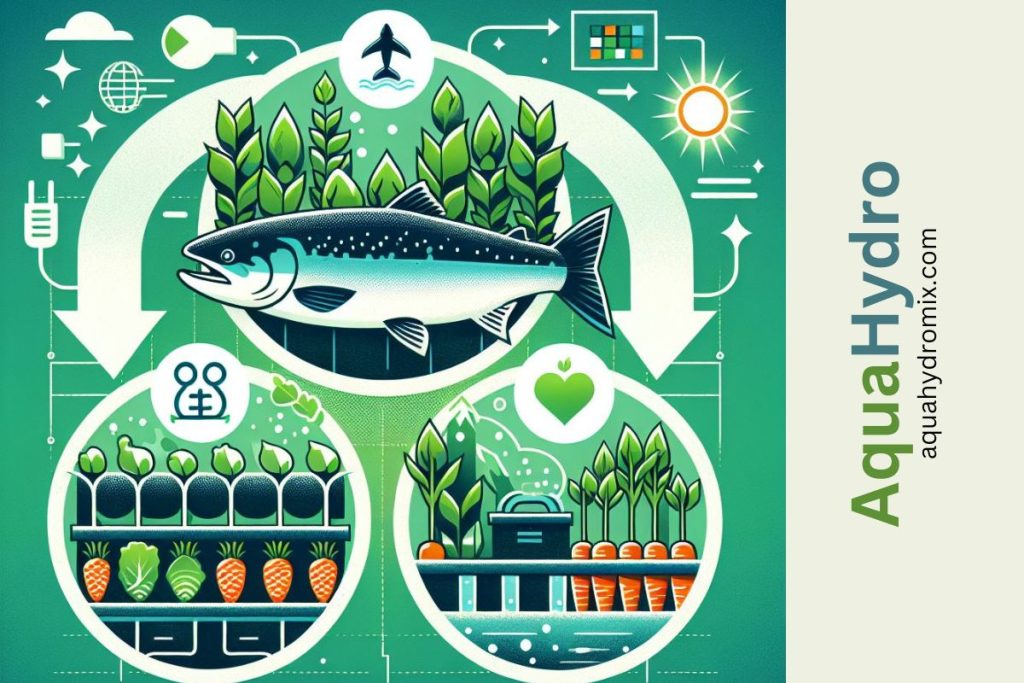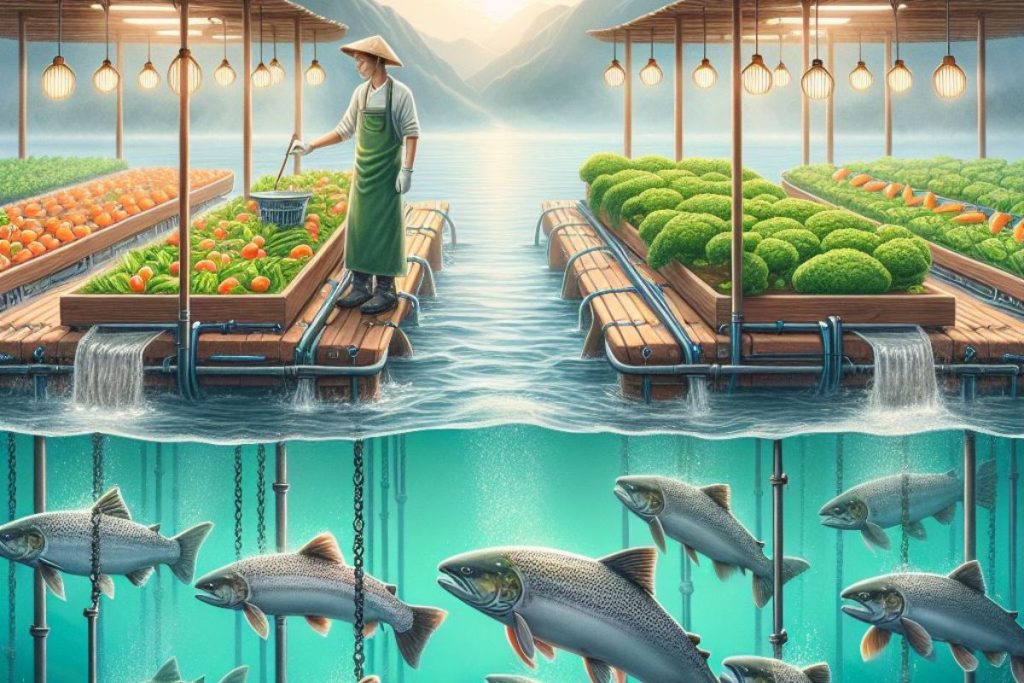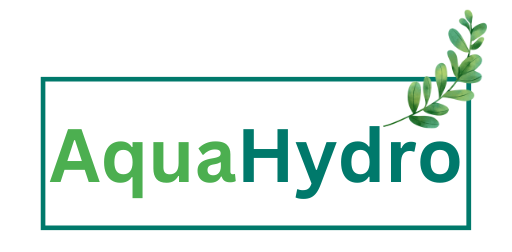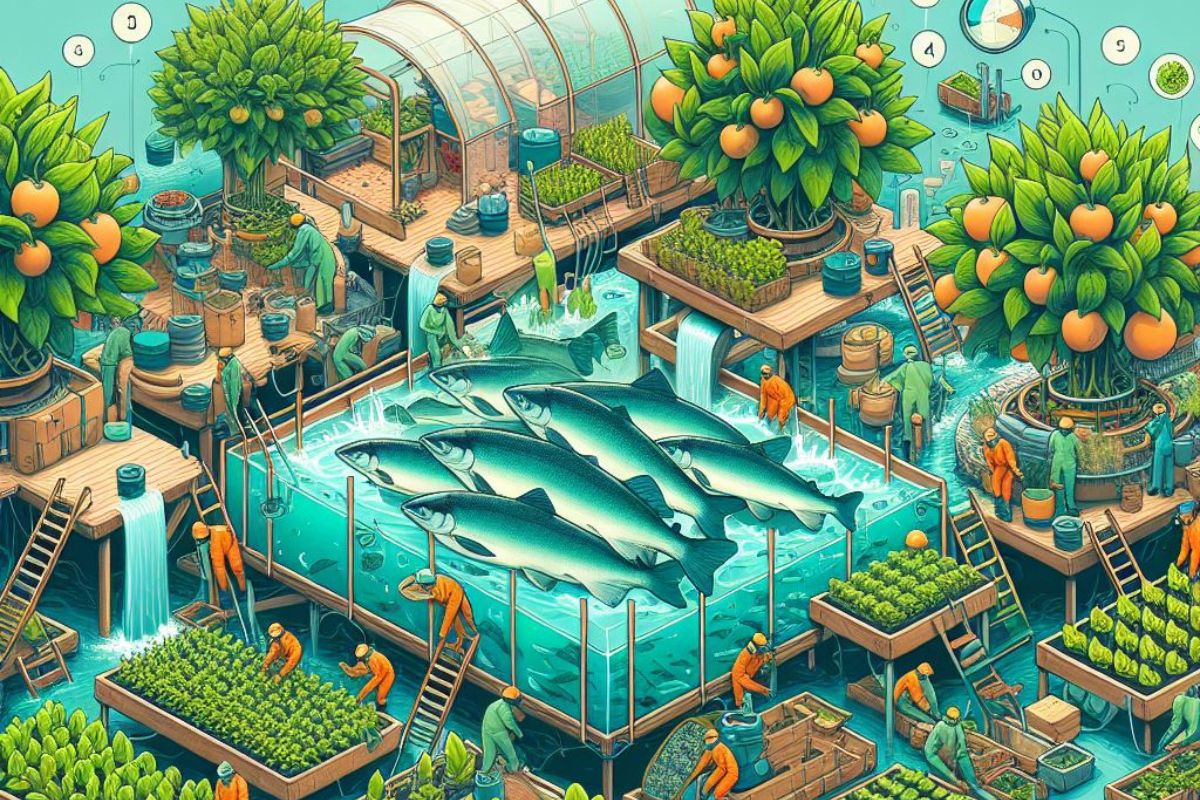Aquaponics, the ingenious combination of aquaculture (fish farming) and hydroponics (soil-less plant cultivation), has been revolutionizing how we produce food. Among the various applications of aquaponics, salmon aquaponics stands out as an innovative and sustainable method. In this article, we’ll delve into the intricacies of salmon aquaponics, exploring how it works, its benefits, and the steps to set up your system.

How Salmon Aquaponics Works
At its core, salmon aquaponics operates on a mutually beneficial relationship between fish and plants. Fish, particularly salmon, in this case, produce nutrient-rich waste. This waste, consisting of ammonia and other organic compounds, serves as a natural fertilizer for plants. The plants play a crucial role by filtering and purifying the water, establishing a self-sustaining ecosystem.
Benefits of Salmon Aquaponics

Environmental Sustainability
Salmon aquaponics significantly reduces the environmental impact compared to traditional farming methods. The closed-loop system minimizes water usage, and the symbiotic relationship between fish and plants eliminates the need for artificial fertilizers.
Efficient Resource Utilization
This method optimizes space and resources by integrating fish farming with plant cultivation. It’s a space-efficient solution that maximizes yield while minimizing inputs.
Healthier Produce
The organic nature of the nutrient source results in healthier and tastier produce. Salmon aquaponics provides a unique opportunity to enjoy fish and vegetables free from harmful chemicals.
Setting Up Your Salmon Aquaponics System
To embark on your salmon aquaponics journey, consider factors such as tank size, pond suitability, and the specific salmon species you want to cultivate. The infrastructure should support both the fish and the plants, creating a harmonious environment.

Tank and Pond Considerations
Choosing the right tank size is crucial, ensuring it accommodates the growth of both fish and plants. Ponds should have proper filtration systems and consider local climate conditions.
Choosing the Right Salmon Species
Different salmon species have varying requirements. Consider factors like water temperature, pH levels, and compatibility with the chosen plant varieties.
Aquaponics Infrastructure
Invest in a well-designed aquaponics system that includes grow beds, biofilters, and aeration systems. Proper planning ensures the efficiency and longevity of your system.
Maintaining Water Quality
Water quality is paramount in salmon aquaponics. Regular monitoring of parameters such as pH, ammonia, and nitrate levels is essential. Understand common challenges like algae growth and implement effective solutions.
Importance of Water Quality
Healthy fish and thriving plants rely on pristine water conditions. Regular testing and adjustments maintain the delicate balance necessary for the success of your aquaponics system.
Common Challenges and Solutions
Facing issues like nutrient deficiencies or waterborne diseases is common. Being proactive and implementing timely solutions ensures a robust and productive system.
Feeding and Nutrition in Salmon Aquaponics
Balancing fish feed with plant nutrients is a delicate task. Explore sustainable feed options that contribute to the overall health of both fish and plants.
Sustainable Feed Options
Consider alternative and sustainable fish feed sources that align with the ecological principles of aquaponics. This contributes to the overall sustainability of your operation.
Impact on Final Produce
The quality of fish and produce is directly influenced by their diet. A well-balanced nutritional approach enhances the flavor and nutritional value of the final harvest.
Harvesting Salmon and Plants
Knowing the right time and method for harvesting is crucial for maximizing yield. Understand the unique aspects of harvesting both fish and vegetables.
Timing and Methods for Salmon Harvesting
Implement ethical and humane practices when harvesting salmon. The timing of harvest affects the quality of the fish and the overall sustainability of your operation.
Maximizing Yield
Optimize the harvest of vegetables and herbs by understanding the growth cycles and ensuring timely harvesting. This contributes to the efficiency and profitability of your aquaponics system.
Economic Viability of Salmon Aquaponics
A comprehensive cost analysis is necessary to understand the economic viability of salmon aquaponics. Explore potential revenue streams and consider the long-term sustainability of your operation.
Cost Analysis
Factor in initial setup costs, operational expenses, and potential returns. A detailed financial assessment provides insights into the feasibility of your venture.
Potential Revenue Streams
Beyond fish and vegetable sales, explore additional revenue streams such as educational programs, guided tours, or collaboration with local businesses.
Long-Term Sustainability
Ensuring the economic sustainability of your salmon aquaponics venture requires careful planning and adaptation to market trends. Stay informed and be prepared to evolve with changing demands.
Scaling Up Your Salmon Aquaponics Operation
For those ready to expand, scaling up your operation requires strategic planning and consideration of technological advancements.
Expanding Production Capacity
Increase production capacity while maintaining the delicate balance of the aquaponics system. Gradual expansion allows for a seamless transition and reduces the risk of disruptions.
Implementing Technological Advancements
Stay abreast of technological developments in aquaponics. Implementing cutting-edge solutions enhances efficiency, productivity, and sustainability.
Challenges and Growth Opportunities
Expanding your salmon aquaponics operation comes with its challenges and growth opportunities. Understanding both aspects is crucial for long-term success.
Challenges
- Infrastructure Upkeep: As you expand, maintaining and upgrading your aquaponics infrastructure becomes increasingly complex. Regular maintenance is essential to prevent system failures.
- Regulatory Compliance: Compliance with local regulations may become more intricate with a larger operation. Stay informed about environmental and agricultural guidelines to ensure legal adherence.
- Market Demand Fluctuations: Larger production capacities expose you to market fluctuations. Diversify your produce and adapt to changing consumer preferences to mitigate risks.
Growth Opportunities
- Diversification of Products: Consider expanding your product range to include specialty fish or unique vegetables. Diversification attracts a broader customer base and enhances your market presence.
- Research and Development: Invest in R&D to stay at the forefront of aquaponics innovation. Developing new techniques or cultivating unique varieties can set your operation apart.
- Collaborations and Partnerships: Explore collaborations with local restaurants, grocery stores, or educational institutions. Building strategic partnerships can open new avenues for distribution and revenue.
Community and Social Impact
Salmon aquaponics extends beyond profitability; it can positively impact local communities.
Local Employment Opportunities
As your operation grows, so does the potential for job creation. Offering employment opportunities within the community contributes to its economic development.
Educational Initiatives
Engage with local schools and community centers to educate the public about the benefits of salmon aquaponics. Hosting workshops or providing educational materials fosters a sense of community involvement.
Community Engagement
Organize events or open houses to involve the community in your aquaponics venture. Creating a sense of shared responsibility enhances public support and ensures the sustainability of your operation.
Comparison with Traditional Salmon Farming
Drawing a comparison between salmon aquaponics and traditional salmon farming highlights the superiority of the former in various aspects.

Environmental Impact
Salmon aquaponics significantly reduces environmental pollution compared to traditional salmon farming. The closed-loop system minimizes water contamination and waste discharge.
Resource Efficiency
Traditional farming consumes vast amounts of water and resources. Salmon aquaponics optimizes resource use, making it a more sustainable and eco-friendly option.
Market Demand and Quality
The growing demand for sustainable and organic produce positions salmon aquaponics favorably in the market. Consumers increasingly value products cultivated through environmentally friendly practices.
Future Trends in Salmon Aquaponics
The future of salmon aquaponics holds exciting possibilities with technological advancements and global adoption.
Technological Advancements
Anticipate advancements in monitoring systems, automation, and integration of smart technologies. Staying technologically updated enhances the efficiency and productivity of your aquaponics system.
Research and Development
Ongoing research will likely introduce new plant and fish varieties suitable for aquaponics. Embrace these developments to diversify your produce and stay ahead in the market.
Global Adoption and Impact
As awareness of sustainable farming practices grows, the global adoption of salmon aquaponics is poised to increase. Position your operation to benefit from the expanding market.
Addressing Concerns and Criticisms
Transparently addressing concerns is essential for building trust and overcoming skepticism.
Environmental Concerns
Acknowledge environmental concerns and emphasize the sustainable practices employed in salmon aquaponics. Highlight the reduced ecological footprint compared to traditional farming.
Animal Welfare Considerations
Address animal welfare concerns by detailing ethical practices in salmon harvesting. Emphasize humane treatment and responsible farming methods.
Regulatory Challenges
Clearly outline your commitment to regulatory compliance. Establishing transparent communication builds trust with regulators and the community.
In conclusion, salmon aquaponics represents a harmonious blend of fish farming and agriculture, offering a sustainable and environmentally friendly method of food production. By understanding the intricacies of setting up and maintaining a salmon aquaponics system, individuals and businesses can contribute to both ecological preservation and local community development.

